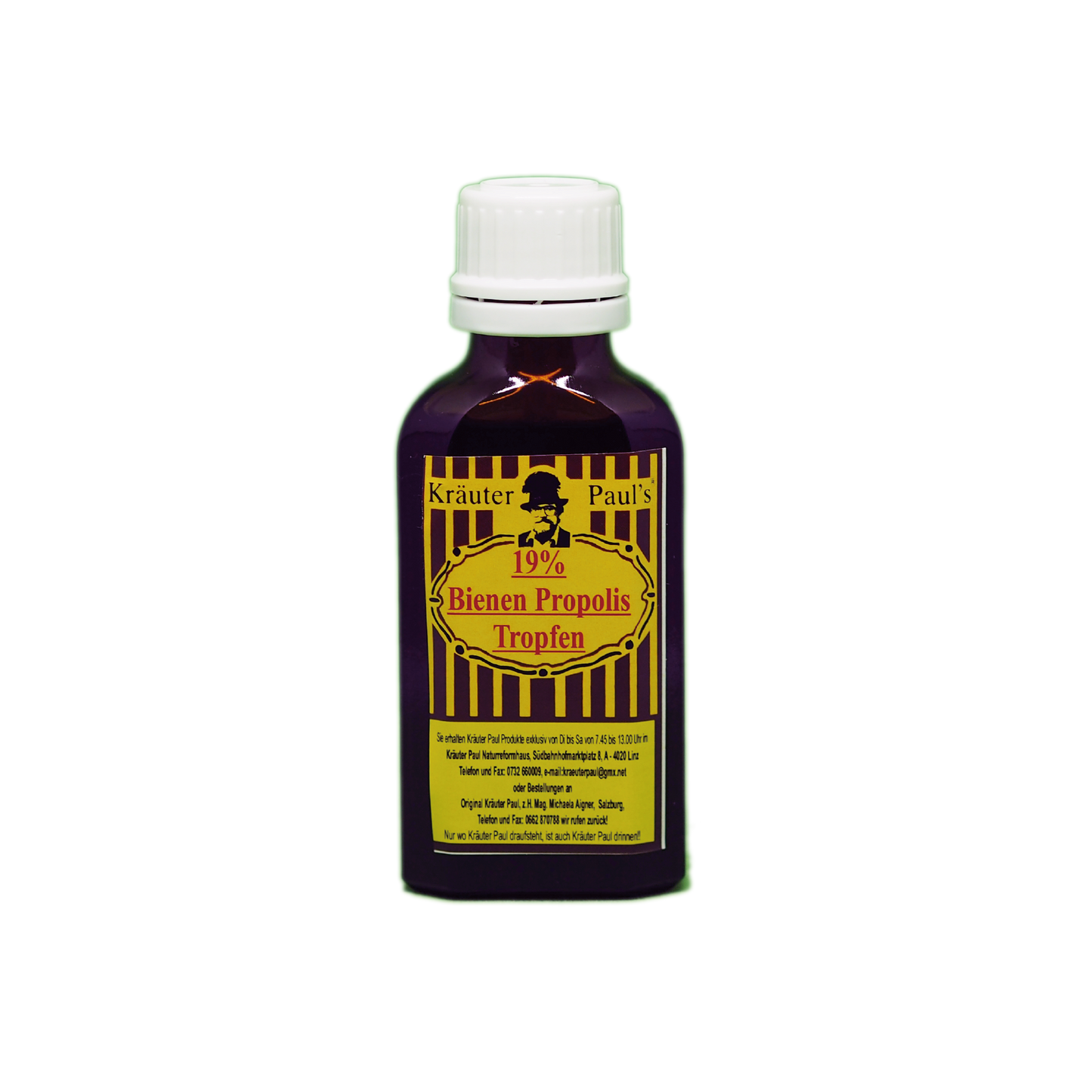Kraeuter Paul
Propolis Tropfen
Propolis Tropfen
Verfügbarkeit für Abholungen konnte nicht geladen werden
Echtes Bienenpropolis in Imkerqualität für Innen und Aussen.
Webshop Info Propolis::
Für was verwende ich Propolis?
Für meine Anwehrkräfte täglich 1 Tropferl
Für mein Zahnfleisch spüle ich damit
Bei Wunden mit Salbe Creme ich mich ein
Bei Halsweh gebe ich ein Tropferl Propolis auf ein Salbeizuckerl
Im Urlaub nehme ich es als Urlaubsapotheke mit
Warum verwende ich Propolis?
Propolis wird von Honigbienen produziert und als harzartiges Baumaterial zur Abdichtung und Instandhaltung des Bienenstocks verwendet. Hauptbestandteile sind Harze verschiedener Bäume, Pollen, Wachse, ätherische Öle und Speichelsekret. In kleinen Mengen sind auch Zucker, Vitamine, Mineralstoffe und Bausteine von Eiweißen (Aminosäuren) enthalten.
Im Bienenstock herrschen im Vergleich zur Umgebungstemperatur erhöhte Temperaturen, eine erhöhte Luftfeuchtigkeit und ein reichhaltiges Nährstoffangebot – die ideale Grundlage zur Vermehrung von Bakterien, Pilzen, Viren und Parasiten. Für verschiedene Arten von Propolis wurde wissenschaftlich bereits eine wachstumshemmende Wirkung auf diese Organismen bestätigt.
Propolis-Wirkung lt Studien:
Studien belegen für Bestandteile des Bienenprodukts unter anderem folgende Wirkungen:
* Antibiotische Wirkung gegen verschiedene krankheitserregende Bakterien wie zum Beispiel Staphylococcus aureus und Salmonella enteritidis
* Antientzündliche, wundheilungsfördernde und Immunsystem-beeinflussende Wirkung
* Antioxidativer Effekt, also Schutz vor freien Radikalen (aggressive Sauerstoffverbindungen, die Zellstrukturen schädigen können)
* Antidepressive Wirkung
Quellen:
* Aktualisierte Stellungnahme Nr. 002/2009 des BfR vom 20. November 2008 zu Propolis und Gelée Royale
* Ansorge, S. et al.: Propolis and some of its constituents down-regulate DNA synthesis and inflammatory cytokine production but induce TGF-beta1 production of human immune cells, in: Z Naturforsch [C] (2003), Ausgabe 58 (7–8), 580–589.
* Botushanov, P. I. et al.: A clinical study of a silicate toothpaste with extract from Propolis, in: Folia Med (Plovdiv) (2001), Ausgabe 43 (1–2), 28–30.
* Cushnie T. et al.: Detection of galangin-induced cytoplasmic membrane damage in Staphylococcus aureus by measuring potassium loss, in: Journal of Ethnopharmacology (2005), Ausgabe 101 (1-3), 243–248.
* da Silva, F. B. et al.: Natural medicaments in endodontics - a comparative study of the anti-inflammatory action, in: Braz Oral Res. (2004), Ausgabe 18 (2), 174–179.
* Duarte, S. et al.: The influence of a novel propolis on mutans streptococci biofilms and caries development in rats, in: Arch Oral Biol. (2006), Ausgabe 51 (1), 15–22.
* Eraslan G. et al.: Evaluation of propolis effects on some biochemical parameters in rats treated with sodium fluoride, in: Pesticide Biochemistry and Physiology (2007), Ausgabe 88 (3), 273–283.
* Gregory, S. R. et al.: Comparison of propolis skin cream to silver sulfadiazine: a naturopathic alternative to antibiotics in treatment of minor burns, in: J Altern Complement Med. (2002), Ausgabe 8 (1), 77–83.
* Hoşnuter, M. et al.: The effect of CAPE on lipid peroxidation and nitric oxide levels in the plasma of rats following thermal injury, in: Burns (2004), Ausgabe 30 (2), 121–125.
* Koo, H. et al.: Effect of a mouthrinse containing selected propolis on 3-day dental plaque accumulation and polysaccharide formation, in: Caries Research (2002), Ausgabe 36 (6), 445-448.
* Münstedt, K. & Hoffmann, S.: Bienenprodukte in der Medizin, Shaker Verlag, 2012
* Ocakci, A. et al.: Role of caffeic acid phenethyl ester, an active component of propolis, against NAOH-induced esophageal burns in rats, in: Int J Pediatr Otorhinolaryngol. (2006) 70 (10), 1731–1739.
* Orsi, R. et al.: Susceptibility profile of Salmonella against the antibacterial activity of propolis produced in two regions of Brazil, in: Journal of Venomous Animals and Toxins including Tropical Diseases (2005), Ausgabe 11 (2), 109–16.
* Padmavathi R. et al.: Therapeutic effect of paclitaxel and propolis on lipid peroxidation and antioxidant system in 7,12 dimethyl benz(a)anthracene-induced breast cancer in female Sprague Dawley rats, in: Life Sci (2006), Ausgabe 78 (24), 2820–2825.


